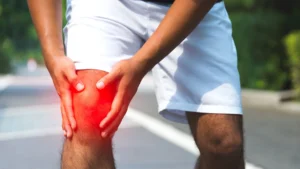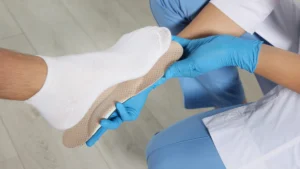Got heel pain that hits like a freight train every morning? That’s probably Plantar Fasciitis.
It’s one of the most common foot issues out there—especially for people who stand all day, run, or just drew the genetic short straw. The good news? The right footwear can make a massive difference.
At Custom Orthopedic Solutions, we help Edmontonians walk pain-free with personalized support and high-quality orthopedic shoes. Below are the top 5 footwear steps you must follow if you’re serious about kicking Plantar Fasciitis in the heel.
The Importance of Arch Support: Why Your Feet Deserve Better
Arch support is crucial for maintaining alignment in your feet, which can significantly alleviate pain associated with plantar fasciitis. Supporting your arches helps distribute your body weight evenly and reduces excessive strain on your plantar fascia. Choosing the right footwear with adequate arch support not only enhances comfort but also promotes proper foot function. Your feet are your foundation; investing in proper support can lead to improved overall well-being and mobility.
Understanding Arch Types and Their Role in Foot Health
Knowing your arch type is key for selecting the right footwear. There are three primary types: normal arches, flat feet, and high arches. Each type has different biomechanical characteristics that affect how your feet absorb shock and distribute weight.
| Arch Type | Characteristics |
|---|---|
| Normal Arches | Well-defined curve; balanced weight distribution. |
| Flat Feet | Low arches; may experience overpronation and alignment issues. |
| High Arches | Excessive curvature; often results in underpronation and increased pressure on the forefoot. |
| Mixed Arches | Various arch heights; may require customized support. |
| Flexible Arches | Changeable arch height; can adapt based on activity level. |
Assume that understanding your arch type can guide you toward specialized footwear that addresses your unique needs and provides optimal support during daily activities.
How Proper Support Alleviates Strain on the Plantar Fascia
Proper footwear with adequate arch support reduces the tension on the plantar fascia, helping to alleviate pain over time. By distributing your body weight evenly and minimizing excessive foot movements, supported shoes ensure that the plantar fascia does not experience undue strain. This can lead to a significant reduction in discomfort and improve overall foot health.
Research shows that wearing shoes with proper support can help minimize inflammation of the plantar fascia. By stabilizing your foot and maintaining proper alignment, supportive shoes prevent excessive stretching and strain on this vital ligament. Many individuals notice a substantial improvement in their ability to perform daily activities without pain when they invest in arch-supportive footwear. Ultimately, prioritizing your foot support can lead to long-lasting relief and increased mobility for those with plantar fasciitis.
Essential Footwear Features for Every Step of the Day
Finding the right footwear goes beyond comfort—it’s about integrating crucial features that support your foot health throughout the day. Look for shoes designed with arch support, ample cushioning, and breathable materials. These characteristics not only alleviate pressure on your feet but also enhance stability and promote proper alignment. Carefully selected footwear will empower you to take each step with confidence, reducing discomfort and preventing further injury associated with plantar fasciitis.
Cushioning Materials: The Difference Between Comfort and Pain
Cushioning materials play a pivotal role in determining your footwear comfort level. Opt for shoes that utilize high-quality foam or gel, which effectively absorbs impact while providing soft support. These materials reduce stress on your plantar fascia, allowing for a more pleasant walking experience. Shoes with inadequate cushioning can exacerbate your foot condition, leading to prolonged discomfort or pain after being on your feet for extended periods.
Heel Height: Finding the Perfect Balance for Stability
Heel height affects not only your overall comfort but also your stability. Shoes with a slight heel (around 1 to 2 inches) often provide a good balance, preventing excessive strain while ensuring enough support for your arches. Flat shoes, while comfortable momentarily, can lead to further tension on the plantar fascia. Conversely, high heels can worsen pain and instability, making it crucial to strike the right balance that fits your daily activities. Test a few styles to understand what feels stable and supportive for your unique foot structure.
The Best Footwear Choices for Plantar Fasciitis Relief
Choosing the right footwear can significantly impact your comfort and recovery from plantar fasciitis. Look for shoes that offer ample arch support, cushioning, and a firm heel counter to provide stability. Styles such as motion control running shoes, supportive sandals, and low-heeled boots with shock-absorbing soles are excellent options. Brands that prioritize biomechanics and comfort often feature technologies that accommodate your foot’s unique needs and promote even pressure distribution throughout your stride.
Top Brands and Models Recommended by Podiatrists
Podiatrists frequently recommend specific brands and models renowned for their supportive features. Asics Gel-Kayano, Brooks Adrenaline GTS, New Balance 860, and Saucony Guide are often highlighted for their superior cushioning and arch support. For sandals, the Vionic Tide II and OOFOS clogs have been proven to alleviate heel pain while providing remarkable support. Each of these options has received endorsements from foot health professionals, meaning your feet are in good hands.
Innovations in Footwear Design That Benefit Plantar Fasciitis Sufferers
Advancements in footwear technology have led to innovative designs specifically aimed at alleviating plantar fasciitis symptoms. Brands are now integrating features such as proprietary cushioning materials, customizable arch supports, and lightweight constructions that enhance comfort while reducing strain on your feet. These innovations not only help manage pain during daily activities but also support long-term foot health, making it easier for you to stay active and mobile.
Recent developments in footwear design focus on creating shoes that adapt to your specific foot shape and gait. For instance, brands like Hoka One One have introduced meta-rocker technology, which promotes a more natural stride, reducing stress on the plantar fascia. Customizable insoles are now more accessible, allowing you to tailor your footwear without the need for expensive orthotics. Additionally, moisture-wicking materials enhance breathability and comfort, ensuring your feet remain dry during wear, further enabling healing and overall foot well-being.
How to Properly Break In New Footwear
Breaking in new footwear is necessary for achieving optimal comfort, especially if you suffer from plantar fasciitis. To ease your transition, start by wearing your new shoes for short periods around the house before transitioning to extended use outdoors. This allows the materials to soften and adapt to your foot shape without overwhelming your arches and soles.
Tips for Gradual Adjustment to Supportive Shoes
Adjusting to supportive shoes requires patience and care. Begin with these steps:
- Wear your new shoes for 30 minutes a day, gradually increasing the time.
- Alternate worn older shoes with your new pairs to allow your feet to acclimate.
- Consider using orthotics that match your new shoes for added support.
- Pay attention to any discomfort; if it occurs, take breaks and extend your adjustment period.
- Assume that your feet need time to adapt to new support levels and avoid overexerting them from the start.
Exercises to Complement Your New Footwear
Integrating specific exercises into your routine can enhance the benefits of your supportive footwear and improve overall foot health. Stretching and strengthening the feet, calves, and even the entire lower body can alleviate discomfort and prevent future pain. Focus on exercises that enhance flexibility and balance, particularly for the plantar fascia and surrounding muscles.
Effective exercises include calf stretches, toe flexors, and arch lifts. For calf stretches, lean against a wall with one foot back, keeping the heel down while you feel the stretch in the back leg. To strengthen your toe flexors, try picking up small objects with your toes. Finally, practicing balance exercises, such as standing on one foot, builds stability and can significantly reduce stress on your plantar fascia, complementing the support your new footwear offers.
Beyond Footwear: A Holistic Approach to Foot Health
Comfortable footwear plays a pivotal role in alleviating plantar fasciitis symptoms, but a comprehensive approach enhances overall foot health. Incorporating lifestyle changes, nutritional considerations, and foot care routines can significantly impact your recovery. Regularly assessing your physical activity and ensuring you’re not overexerting yourself will help protect your feet. Prioritizing rest and recovery, along with maintaining a healthy weight, can also relieve pressure on your plantar fascia and aid in healing.
Stretching and Strengthening: Key Techniques for Relief
Dedicating time to stretching and strengthening your feet and calves can alleviate pain and promote healing. Practicing calf stretches and toe flexor stretches not only increases flexibility but also supports the arch of your foot. Joining a targeted exercise routine can help build resilience in your feet, allowing you to better manage daily activities without aggravating your condition.
When to Seek Professional Help: Signs You Shouldn’t Ignore
Persistent pain that interferes with daily activities, swelling, or numbness in your heels or arches signals the need for professional assessment. If your symptoms do not improve with home treatments such as rest, ice, or stretching, it’s necessary to consult a healthcare provider. Early intervention can prevent complications and provide tailored strategies for your specific foot health needs.
Knowing when to seek professional help can make a significant difference in your healing journey. If you’re experiencing foot pain for more than a few weeks or if over-the-counter pain relievers fail to provide relief, don’t hesitate to reach out to a podiatrist. Advanced treatments—ranging from physical therapy to custom orthotics—are available, and understanding your options can help you regain mobility and comfort efficiently. Additionally, if you notice any signs of infection, such as redness, warmth, or fever, it’s imperative to seek medical attention promptly.
The Bottom Line For Plantar Fasciitis Relief
Plantar Fasciitis won’t fix itself—but the right footwear does a lot of the heavy lifting. Prioritize real arch support, deep heel cushioning, a stable (semi-rigid) sole, a locked-in fit, and purpose-built insoles you replace on schedule. Do those five things consistently and you’ll take pressure off the fascia, cut the heel pain, and move like yourself again.
Want relief without the guesswork? Custom Orthopedic Solutions (Edmonton) offers gait assessments, custom orthotics, and curated footwear that actually helps Plantar Fasciitis—not just “feels comfy.”
Book your fitting today: (780) 426-3338 • customorthopedic.ca





